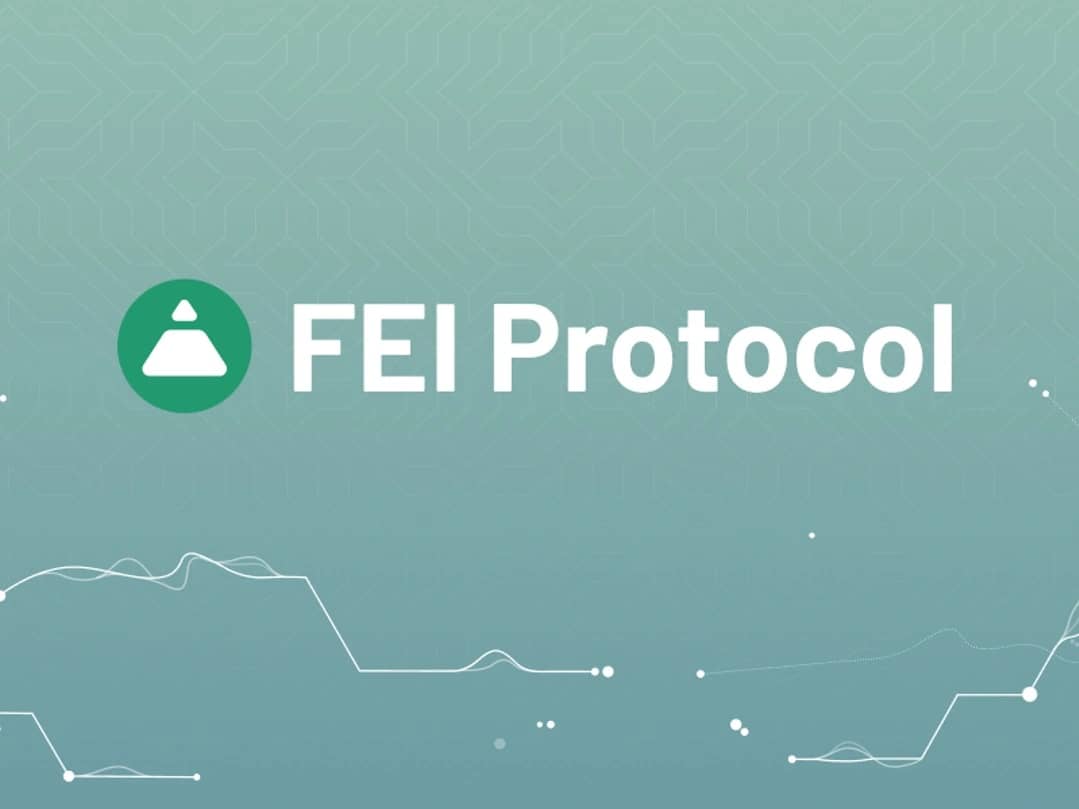위키 구독하기
Share wiki
Bookmark
Fei Protocol
Fei Protocol
**Fei 프로토콜(Fei Protocol)**은 이더리움(Ethereum) 기반의 탈중앙화되고, 공정하며, 유동적이고, 확장 가능한 스테이블코인 플랫폼을 목표로 합니다. Fei 프로토콜의 비전은 미크로네시아 야프 섬의 고대 석화폐인 라이(Rai) 또는 페이(Fei)에서 영감을 얻었습니다.[1][3][4][5]
2021년 초 출시될 예정입니다.[2]
개요
- FEI는 직접 인센티브라는 새로운 메커니즘으로 안정화됩니다.
- FEI는 발행되는 스테이블코인입니다.
- TRIBE는 거버넌스 토큰입니다.
- 기존 스테이블코인의 포크(fork)가 아닙니다.
- 확장성, 유동성, 공정성 및 낮은 변동성을 위해 설계되었습니다.
- 완전한 탈중앙화 자율 조직(DAO)을 출시합니다.
- 프로토콜 제어 가치(PCV)를 제안합니다.
소개
스테이블코인(FEI)
FEI는 직접 인센티브라는 새로운 종류의 스테이블코인 메커니즘을 도입합니다. 자본 효율성이 높고, 공정한 분배를 목표로 하며, 완전히 탈중앙화됩니다. 이 프로토콜은 자체적으로 제어하는 가치를 사용하여 유동적인 2차 시장을 유지합니다. [1][2]
$FEI 공급 확장 방식
$FEI 스테이블코인은 수요를 추적하는 무제한 공급량을 가지고 있습니다. FEI는 본딩 곡선을 따라 판매를 통해 유통됩니다. 이 곡선은 $1 PEG에 접근하고 고정됩니다. FEI에 대한 새로운 수요가 발생하면 사용자는 본딩 곡선에서 구매하여 FEI를 얻을 수 있습니다. 가격 함수는 초기 채택자에게 FEI 구매에 대한 보상을 제공하기 위해 낮게 시작됩니다. Fei 프로토콜은 모든 ERC-20으로 표시된 본딩 곡선 생성을 지원합니다. 출시 시에는 ETH로 표시된 단일 곡선만 포함됩니다. [4]
본딩 곡선
ETH 본딩 곡선은 가격을 $1로 고정하기 전에 부트스트래핑을 위한 목표 FEI 공급량을 갖습니다. 이 목표는 Scale로 알려져 있으며, Scale에 도달하면 부트스트래핑 단계가 종료됩니다. Scale은 다른 DeFi(탈중앙화 금융)와의 통합을 위해 충분히 큰 250,000,000 FEI로 설정됩니다. Scale 이후 본딩 곡선 가격은 거버넌스 가능한 버퍼를 PEG 위에 고정합니다. 이 가격은 전체 생태계에서 상한선을 만듭니다. 아비트라주어는 다른 곳에서 가격이 더 높으면 본딩 곡선에서 구매하고 2차 시장에서 판매할 수 있습니다. [4]
프로토콜 제어 가치(PCV)
사용자는 본딩 곡선에서 FEI를 판매할 수 없습니다. 대신 프로토콜은 유입되는 ETH를 프로토콜 제어 가치(PCV)로 유지합니다. Fei 프로토콜은 사용자가 FEI를 ETH로 다시 판매할 수 있는 유동적인 2차 시장을 만들기 위해 PCV를 배포합니다. [4]
PCV는 플랫폼이 스마트 계약에 잠긴 자산을 직접 소유하는 총 가치 잠금(TVL) 개념의 하위 집합입니다. PCV는 영구적이기 때문에 대부분의 TVL 애플리케이션에서 일반적인 IOU보다 더 강력한 사용 사례입니다. PCV는 프로토콜에 수익 지향적이지 않은 활동에 참여할 수 있는 더 큰 유연성을 제공합니다. 이러한 활동은 PEG의 안정성 유지와 같은 더 근본적인 목표와 일치할 수 있습니다. [4]
PCV 사용 사례
거버넌스 재무부 및 보험 기금과 같은 일반적인 사용 사례는 PCV의 유형입니다. 다른 가능성으로는 DeFi 사용자를 위한 보장된 유동성 또는 가격 안전장치가 있습니다. IOU 모델과 달리 PCV는 취소할 수 없습니다. PCV 플랫폼의 거버넌스 토큰은 더 깊은 가치 캡처와 그에 상응하는 책임을 축적합니다.
직접 인센티브
Fei 프로토콜에서 언급한 대로: [3]
직접 인센티브 스테이블코인은 스테이블코인의 거래 활동과 사용 모두가 인센티브를 받고, 보상과 페널티가 가격을 PEG로 유도하는 스테이블코인입니다. 일반적으로 여기에는 허브 역할을 하는 최소 하나의 인센티브가 주어진 거래소가 포함됩니다. 다른 모든 거래소와 2차 시장은 인센티브가 주어진 거래소와 아비트라주할 수 있습니다. 이는 전체 생태계에서 PEG를 유지하는 데 도움이 됩니다.
Fei 프로토콜은 민팅과 버닝을 통해 Uniswap 거래량에 인센티브를 제공하여 이 목표를 달성합니다. 이러한 인센티브는 PEG와의 거리에 비례하여 트레이더의 잔액에 직접 적용됩니다. 즉, 매도량이 클수록 소각량이 커집니다. 프로토콜은 가격을 PEG로 다시 올리기 위해 민팅을 통해 트레이더에게 인센티브를 제공합니다. 사용된 공식은 PEG 아래의 모든 변동성이 순 감소성임을 보장합니다. 이는 현재 수요에 비례하여 공급량을 적절한 수준으로 낮추는 데 도움이 됩니다. [3]
Fei 프로토콜의 직접 인센티브 구현은 Ampleforth 및 Yam과 같은 리베이싱 토큰의 사촌과 같습니다. 사용자 잔액을 직접 운영하지만, 인센티브가 주어진 행동에 적극적으로 참여하는 사용자의 잔액만 운영합니다. FEI 매도 압력이 높은 경우 판매자는 관련 감소 비용을 부담합니다. 홀더는 트레이더가 가격을 복원하지 않더라도 프로토콜이 가격을 지원한다는 사실에 확신을 가질 수 있습니다. 장기적인 지원 능력은 감소에 의해 지원됩니다. 이러한 새로운 특성은 FEI에 대한 높은 충실도 PEG로 이어집니다. [3]
거버넌스 토큰(TRIBE) & DAO
이 프로젝트는 첫날부터 완전히 탈중앙화된 탈중앙화 자율 조직(DAO)으로 출시됩니다. $TRIBE 토큰은 DAO를 제어합니다. TRIBE 보유자는 다음과 같은 조치에 대해 투표할 수 있습니다.
- 새로운 토큰에 새로운 본딩 곡선 추가 또는 기존 곡선의 가격 함수 조정
- 새로운 유입 자금 또는 기존 PCV에 대한 PCV 할당 조정
프로토콜은 TRIBE 토큰의 일부를 FEI 스테이킹 풀에 할당합니다. 사용자는 FEI를 예치하고 풀에 대한 TRIBE 드립의 비례 비율을 받을 수 있습니다. 개발팀과 투자자는 다른 부분을 보유합니다. 일정 비율은 제네시스 그룹과 초기 DeFi 오퍼링으로 나뉩니다. [1]
잘못된 내용이 있나요?
